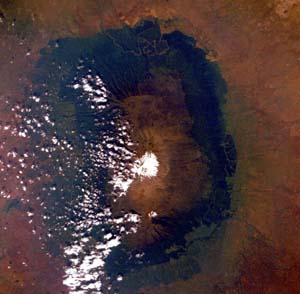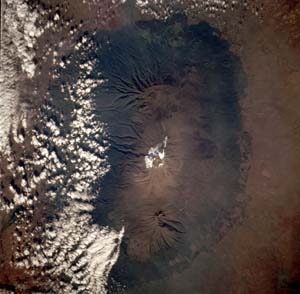Mount Kilimanjaro, with its 5898 meters (19340 feet) the
highest and most celebrated mountain in Africa, is the centerpiece in this east-looking, low-oblique
photograph. Looming some 4900 meters (16000 feet) above the plains that spread out from its base, the
mountain dominates its surroundings. Composed of three separate volcanoes, massive and complex Kilimanjaro
covers an area 100 kilometers (60 miles) long and 65 kilometers (40 miles) wide. The volcanoes, whose lava
fields overlapped and partially obliterated each other, began erupting approximately 2 million years ago. At
the center is the culminating massif, Kibo (snow-covered peak near the center of the photograph), flanked by
the lower summits of Mawenzi to the east and Shira to the west. The peaks of Kibo and Mawenzi are joined by
a broad saddle 11 kilometers (7 miles) long. Because of Kilimanjaro’s great height, the mountain
influences its own weather. Winds incoming from the Indian Ocean are deflected upward by the slopes and drop
their moisture as rain and snow. This moisture results in a variety of vegetative zones that contrast
dramatically with the savanna grasses and semidesert scrub on the surrounding plains. The mount’s lower
slopes, probably once forested, have been cleared for the cultivation of coffee, corn, and other crops. At
higher elevations in approximately 3000 meters (9800 feet) lies a belt of tropical rain forest that gives
way to grasslands and moorlands. This belt, in turn, is replaced by high-altitude desert near 4400 meters
(14500 feet). At the highest elevations is a zone of permanent ice and snow that is responsible for the name
Kilimanjaro, which in Swahili means "the mountain that glitters."

Photo taken in February 1984 during Space Shuttle mission STS-41B.

 Vergrößerungen: Vergrößerungen:  , ,  , ,  , ,  & &  . . |
Mount
Kilimanjaro, the highest and most famous mountain in Africa, is located in Tanzania just adjacent to the
Kenya border. Three distinct volcanoes can be seen in this near-vertical photograph: Kibo (center volcano)
with the highest peak that reaches 5898 meters (19340 feet) above sea level and a permanent glacier and snow
field at its summit; Shira (most westerly), the oldest that has been eroded into a plateau-like feature
standing 3778 meters (12395 feet) above sea level; and Mawenzi (most easterly) with a well-defined peak that
reaches 5354 meters (17564 feet) above sea level. The overlapping lava flows from these three volcanoes have
almost obliterated their individual uniqueness into a single complex volcanic feature. The southern flanks
of the mountain are more deeply eroded than northern slopes. Perhaps the cloud buildup indicates the
increased severity of erosion is caused by more precipitation on the southern slopes than on the northern
slopes. (Refer to the left photo, which was taken 10 years earlier, to evaluate the change in the area of
ice and snow and slight changes in land use patterns near the base of the mountains.)

Photo taken on November 9, 1994, during Space Shuttle mission STS-66.

 Vergrößerungen: Vergrößerungen:  , ,  , ,  , ,  & &  . . |



